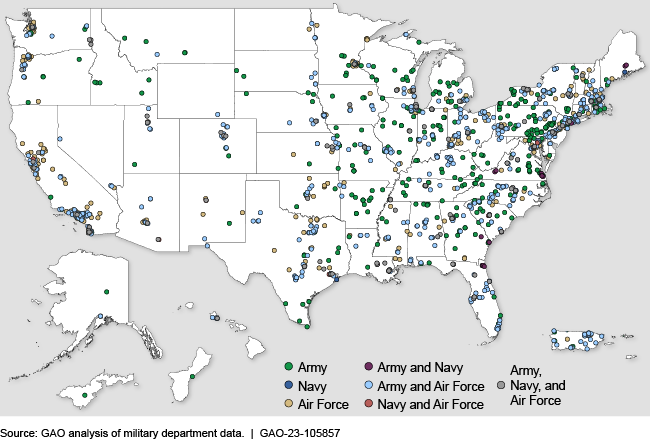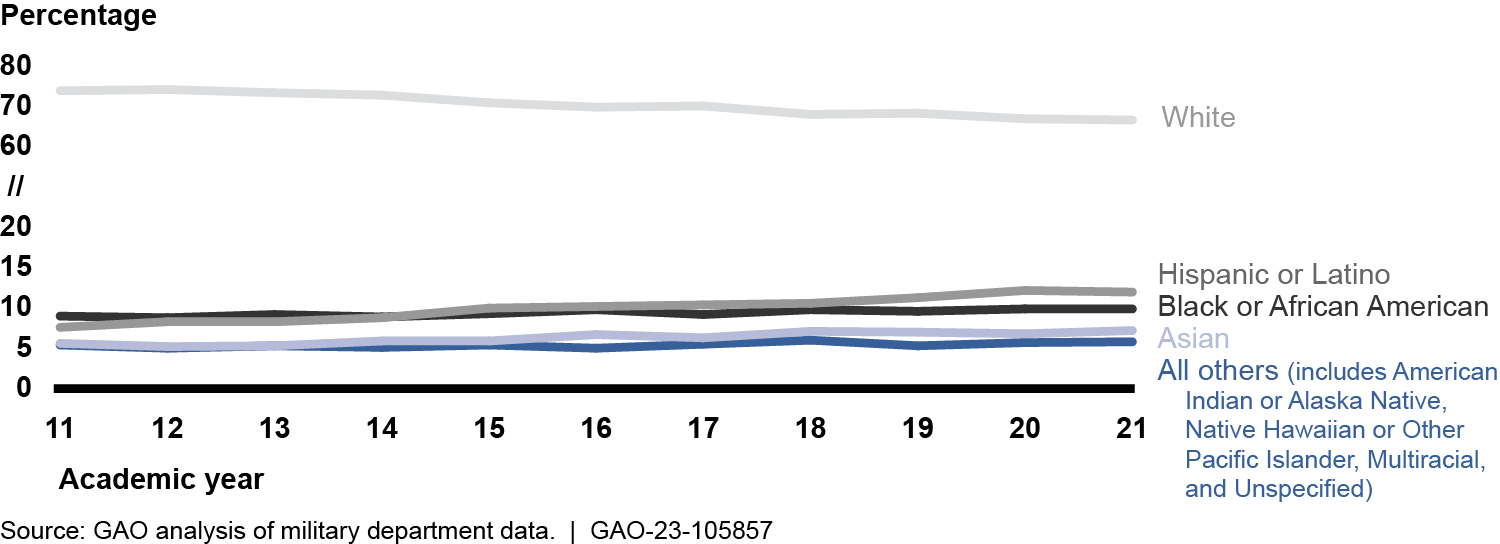Senior Reserve Officers' Training Corps: Actions Needed to Better Monitor Diversity Progress
Fast Facts
Reserve Officers' Training Corps (ROTC) programs are DOD's largest source of military officers. As such, ROTC programs can help cultivate diversity in the military.
The population of military officers from ROTC programs became more diverse by race, ethnicity, and gender from academic years 2011-2021. For example, the percentage of officers who were White men decreased by 9.4%, while the populations of Blacks or African Americans, Hispanics or Latinos, Asians, and women increased.
However, DOD hasn't developed a comprehensive approach to evaluating the ROTC program's contributions to diversity among its officers. We recommended it do so.
Map of schools with at least one ROTC unit of any type

Highlights
What GAO Found
The population of Senior Reserve Officers’ Training Corps (ROTC)-commissioned officers became more diverse for race and ethnicity and gender in academic years 2011–2021. For example, during this period, the percentage of White officers decreased from 73.6 percent to 66.3 percent, while the percentages of Blacks or African Americans, Hispanics or Latinos, and Asians increased. Also, ROTC-commissioned officers have increasingly come from economically advantaged areas—that is, from those with poverty and unemployment rates below the national average and household incomes above the national median.
ROTC-Commissioned Officer Trends for Race and Ethnicity, Academic Years 2011–2021

Generally, the racial and ethnic and gender makeup of ROTC units did not align with the student body of their host schools, most notably for gender. However, Historically Black Colleges and Universities (HBCUs) and Minority-Serving Institutions (MSIs) generally had a more racially and ethnically diverse population for ROTC units to draw from. The military departments had ROTC units at 69 percent of HBCUs and 19 percent of MSIs.
The military departments have not developed a comprehensive approach for evaluating ROTC program contributions to a diverse officer corps, limiting their ability to inform decisions regarding any appropriate program modifications.
- The Navy and Air Force developed applicant goals—based on the eligible population—to evaluate the diversity of ROTC applicants, but the Army has not.
- These applicant goals do not share a consistent comparison group with the Department of Defense’s (DOD) stated diversity goal to reflect the U.S. population.
- Each military department has conducted the required performance evaluations of ROTC units, but has not fully evaluated the extent to which the units contribute to a diverse officer corps.
- The military departments have not submitted the required resource documents to ensure resources are allocated effectively within the ROTC program or to determine whether—based on resources and performance—modifications to the program are advisable.
Why GAO Did This Study
The Senior ROTC program is DOD’s largest source of military officers. It produced more than 94,000 officers since academic year 2011 from ROTC units in every U.S. state and many U.S. territories. As such, the program can make significant contributions to DOD’s efforts to cultivate diversity.
Senate Report 117-39, accompanying a bill for the National Defense Authorization Act for Fiscal Year 2022, includes a provision for GAO to review the ROTC program’s contributions to a diverse military officer corps. GAO, among other things, (1) describes ROTC-commissioned officer diversity trends for academic years 2011–2021, by race, ethnicity, and gender, and socioeconomic makeup; (2) describes whether ROTC unit racial, ethnic, and gender makeup aligned with school makeup; and (3) assesses the extent to which the military departments have evaluated and, as necessary, modified ROTC programs to better ensure they contribute to a diverse officer corps.
GAO analyzed academic years 2011–2021 race and ethnicity and gender data for ROTC units and schools and Census Bureau socioeconomic data.
Recommendations
GAO makes four recommendations including that the Army develop quantifiable diversity goals, DOD establish a consistent process to identify a comparison group, the military departments collect and analyze quantifiable diversity data in program evaluations, and the military departments evaluate both the performance and resources of ROTC programs. DOD concurred with the recommendations.
Recommendations for Executive Action
| Agency Affected | Recommendation | Status |
|---|---|---|
| Department of the Army | The Secretary of the Army should develop quantifiable ROTC diversity goals, such as applicant pool goals, that aid in the evaluation of Army efforts to recruit a diverse workforce. (Recommendation 1) |
The Army concurred with this recommendation. In October 2024, the Army stated that it acknowledges the benefits of having a diverse cadet population for both ROTC, as well as for the Army overall. To address the recommendation, the Army stated that it will establish a working group to identify a comparison group which will be used to establish targets for desired Senior Reserve Officers' Training Corps (SROTC) applicants and first-year Army SROTC enrollment, and initiate analysis towards reaching these targets. The Army further stated a desire to establish quantifiable ROTC participation and accession targets which are aligned with higher-level Department of Defense diversity objectives; therefore, once OSD's directed common comparison group as identified and instituted under recommendation #2 is established, the Army will adjust these goals and targets as necessary to aid the Army in its quantifiable evaluation of SROTC diverse workforce contributions - with a focus on achieving uniformity of the demographic makeup of applicants and first-year cadets as compared to the defined comparison group. The Army has an estimated completion date of June 30, 2025, for these actions. We will continue to follow up on the status of this recommendation.
|
| Department of Defense | The Secretary of Defense should ensure that the Under Secretary of Defense for Personnel and Readiness, in coordination with the Secretaries of the military departments, establishes a consistent process to identify a comparison group to evaluate progress toward racial, ethnic, and gender diversity (i.e., whether to use the U.S. population, the service-eligible population, or the U.S. population with the age and education required for service for comparison). (Recommendation 2) |
DOD concurred with this recommendation. In October 2024, DOD stated that it initiated a working group to review and prepare an updated draft of DOD Instruction 1215.08, "Senior Reserve Officers' Training Corps (ROTC) Programs" on September 22, 2023. The working group is prioritizing the review of the portion of the instruction which provides guidance on ROTC program assessments, with the intent to include an update within the document providing clear instructions and a process for a demographic comparison to consistently reflect trends and progression in SROTC diversity in the reissuance of this instruction. DOD has an estimated completion date of June 30, 2025, for these actions. We will continue to follow up on the status of this recommendation.
|
| Department of Defense | The Secretary of Defense should ensure that the Under Secretary of Defense for Personnel and Readiness develops guidance that requires the military departments to (1) collect and analyze ROTC unit demographic data as part of the annual evaluations, and (2) use those data, not as viability criteria, but as a means to evaluate ROTC contributions to a diverse officer corps. (Recommendation 3) |
DOD concurred with this recommendation. In October 2024, DOD stated that it initiated a working group to review and prepare an updated draft of DoDI 1215.08, "Senior Reserve Officers' Training Corps (ROTC) Programs" on September 22, 2023. The working group is prioritizing the review of the portion of the instruction which provides guidance on ROTC program assessments. Once a common comparison group is determined as described in recommendation #2 of this audit, they anticipate language in the updated draft instruction will include clear instructions or a process for a demographic comparison group and a requirement for military departments to collect and analyze this data within their ROTC unit programs as part of their annual assessments. DOD anticipates completing these actions by June 30, 2025. We will continue to follow up on the status of this recommendation.
|
| Department of Defense | The Secretary of Defense should ensure that the Under Secretary of Defense for Personnel and Readiness requires the military departments to evaluate both the performance and resources of ROTC units and take any corrective actions, as appropriate, to better achieve ROTC program, military department, or DOD diversity goals. (Recommendation 4) |
DOD concurred with this recommendation. In October 2024, DOD stated that it initiated a working group to review and prepare an updated draft for DoDI 1215.08, "Senior Reserve Officers' Training Corps (ROTC) Programs" on September 22, 2023. The working group is considering how the Office of the Under Secretary of Defense for Personnel and Readiness can implement policies to better assist the Military Departments in evaluating the performance and resources of ROTC units, and develop corrective actions, as appropriate, to achieve diverse programs. DOD anticipates completing these actions by June 30, 2025. We will continue to follow up on the status of this recommendation.
|
